Próba przejścia na stronę internetową i napotkanie błędu “Nie znaleziono strony” jest frustrujące. Może to zaszkodzić twojej marce, a odwiedzający mogą po prostu przejść do innej witryny internetowej.
W WPBeginner rozumiemy, że niedziałające odnośniki mogą zaszkodzić doświadczeniu użytkownika i SEO. Dlatego używamy All in One SEO, aby przekierować naszych użytkowników do treści, których szukają.
Gdy ktoś przejdzie na twoją witrynę za pomocą starego odnośnika do strony, która została przeniesiona, przekierowanie 301 automatycznie przeniesie go na nową stronę, dzięki czemu nie zobaczy błędu 404 “Nie znaleziono strony”.
W tym artykule pokażemy ci, jak tworzyć przekierowania 301 w WordPressie za pomocą All in One SEO i innych narzędzi, abyś mógł zaoferować lepsze wrażenia użytkownika i poprawić ranking słów kluczowych.

Czym jest przekierowanie w WordPress?
Przekierowanie to sposób, w jaki twoja witryna internetowa WordPress automatycznie wysyła użytkowników na nowy adres, gdy strona, którą chcą przejść, została przeniesiona lub zastąpiona. Jest to podobne do sposobu, w jaki wpis przekierowuje twoją pocztę po przeprowadzce.
Istnieją różne rodzaje przekierowań, które są oznaczone numerami takimi jak 301, 302 i 307. Automatycznie kierują one przeglądarkę internetową twojego użytkownika na inny adres URL, gdy próbuje on przejść na stronę, która nie istnieje.
W tym przewodniku dla początkujących skupimy się na przekierowaniach 301, ponieważ są one najważniejszym rodzajem. Informują one przeglądarkę, że strona została trwale przeniesiona do nowej lokalizacji i że nie zamierzasz przenosić jej z powrotem.
To powiedziawszy, przyjrzyjmy się, kiedy powinieneś użyć przekierowania 301.
Kiedy potrzebne jest przekierowanie 301 w WordPress?
Głównym powodem korzystania z przekierowania 301 jest sytuacja, w której twoja witryna lub strona w witrynie została przeniesiona i zamiast tego chcesz skierować użytkownika na nową stronę.
Jest również potrzebny, gdy planujesz zmienić bezpośredni odnośnik wpisu lub strony.
Jeśli nie skonfigurujesz przekierowania, spowoduje to, że twoi użytkownicy zobaczą błąd 404, gdy strona nie zostanie znaleziona. Zapewnia to złe wrażenia użytkownika i może mieć wpływ na twój WordPress SEO.

Możesz również stracić cenne linki zwrotne, jeśli na twojej witrynie znajduje się wiele niedziałających odnośników. Spowoduje to znaczny spadek autorytetu twojej domeny i rankingu słów kluczowych.
Właśnie dlatego przekierowania 301 są bardzo ważne. Pozwalają one poinformować wyszukiwarki i twoich użytkowników, że strona, do której próbują dotrzeć, została trwale przeniesiona do nowej lokalizacji.
W ten sposób cały ruch z twojej starej strony i linki zwrotne zostaną przeniesione na nową stronę.
Przyjrzyjmy się teraz, jak tworzyć przekierowania 301 w WordPress. Pokażemy ci, jak zrobić to łatwo za pomocą kilku wtyczek przekierowań WordPress i ręcznie za pomocą kodu.
Film instruktażowy
Jeśli wolisz pisemne instrukcje, czytaj dalej.
Metoda 1: Tworzenie przekierowań 301 za pomocą wtyczki AIOSEO
Najprostszym sposobem zarządzania i tworzenia przekierowań 301 jest użycie wtyczki All in One SEO (AIOSEO) WordPress. Jest to najlepsza wtyczka SEO dla WordPress i jest używana przez ponad 3 miliony profesjonalistów do poprawy SEO ich witryn.
AIOSEO oferuje potężny dodatek do menedżera przekierowań, który bardzo ułatwia znajdowanie niedziałających odnośników na twojej witrynie internetowej i ustawianie przekierowań 301 w celu ich poprawki.
Uwaga: Do korzystania z menedżera przekierowań wymagana jest aplikacja AIOSEO Pro. Istnieje również darmowa wersja AIOSEO, ale nie obejmuje ona przekierowań 301.
Najpierw musisz zainstalować i skonfigurować wtyczkę AIOSEO Pro na twojej witrynie internetowej. Aby uzyskać więcej informacji, zapoznaj się z naszym przewodnikiem krok po kroku, jak poprawnie skonfigurować All in One SEO.
Po włączeniu wtyczki należy przejść do All in One SEO ” Redirects w twoim kokpicie WordPress, a następnie kliknąć przycisk “Activate Redirects”.
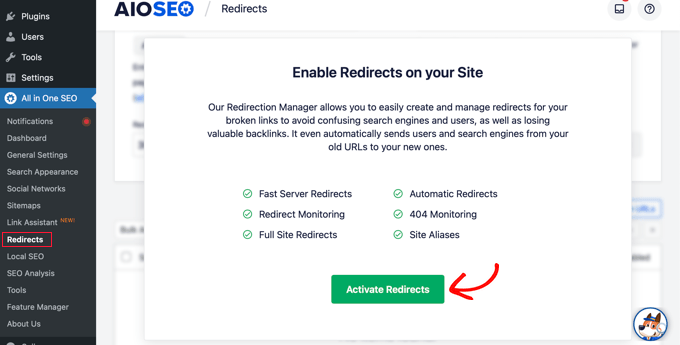
Następnie można kliknąć kartę “Ustawienia” i wybrać “PHP” jako metodę przekierowania.
Jest to najprostsza metoda tworzenia przekierowań i nie wymaga żadnej konfiguracji po stronie serwera.
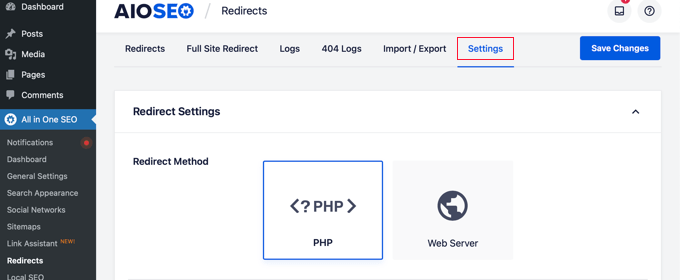
AIOSEO pozwala również wybrać metodę przekierowania serwera WWW. Wymaga to jednak skonfigurowania Apache lub NGINX na twoim serwerze WWW. Wymaga to wiedzy technicznej i nie jest zalecane dla początkujących.
Tworzenie przekierowań 301
Teraz możesz tworzyć przekierowania 301. Aby rozpocząć, przejdź do karty “Przekierowanie”.
Najpierw wpisz odnośnik, który chcesz przekierować w polu “Source URL”. Następnie należy wpisz nowe miejsce docelowe dla odnośnika w polu “Docelowy adres URL”.
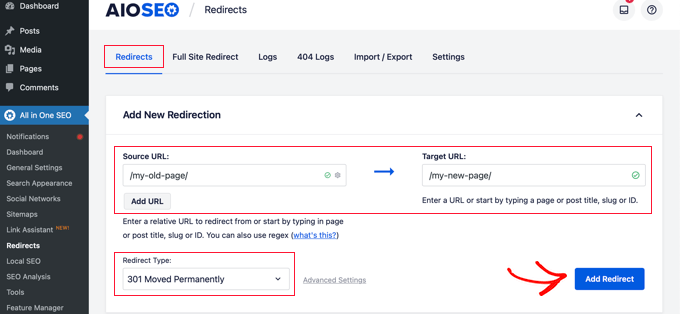
Teraz upewnij się, że rodzaj przekierowania to “301 Moved Trale”, a następnie kliknij przycisk “Dodaj przekierowanie”.
Jeśli chcesz przekierować wiele adresów URL do nowej lokalizacji, po prostu kliknij przycisk “Utwórz adres URL” pod polem Źródłowe adresy URL.
Następnie można przewinąć w dół, aby zobaczyć logi utworzonych przekierowań. Pokazuje on liczbę osób, które przeszły na przekierowany odnośnik w kolumnie “Trafienia” oraz opcję włączania lub wyłączania poszczególnych przekierowań 301.

Dodawanie przekierowań 301 w celu poprawki błędów 404
AIOSEO może również pomóc w śledzeniu stron błędów 404 i ich poprawkach.
Aby włączyć tę opcję, należy przewinąć w dół do sekcji “Dzienniki przekierowań” na karcie Ustawienia. Następnie włącz opcje “404 Logs” i “Redirect Logs”.
Można również wybrać okres przechowywania logów. Zalecamy przechowywanie ich przez maksymalnie jeden miesiąc, aby zapewnić płynne i szybkie działanie serwera.
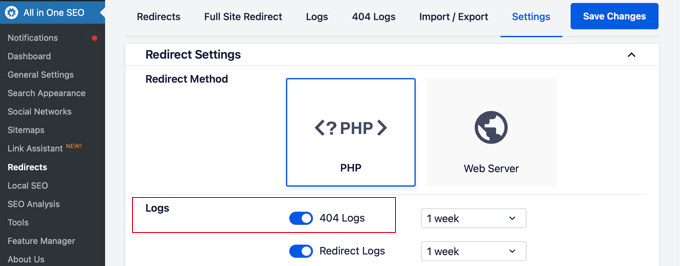
Po włączeniu tych opcji należy kliknąć przycisk “Zapisz zmiany”.
Teraz w sekcji Przekierowania powinna pojawić się nowa karta “404 Logs”. To tutaj AIOSEO będzie śledzić i pokazywać twoje niedziałające odnośniki i pozwoli ci ustawić przekierowania. Zobaczysz również liczbę przejść na odnośnik w sekcji “Trafienia” oraz datę i godzinę ostatniego dostępu.
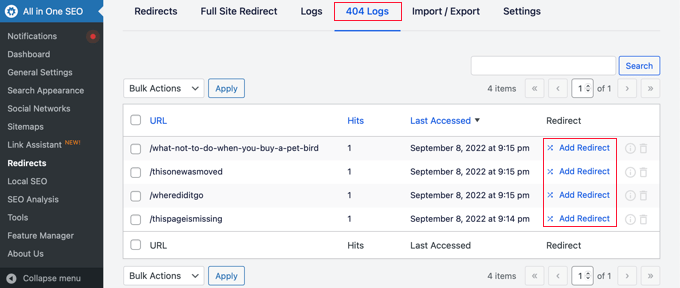
Uwaga: Po pierwszym włączeniu logów 404 nie znajdziesz żadnych danych. Wtyczka zaczyna rejestrować strony błędów 404 dopiero po włączeniu ustawienia.
Następnie kliknij odnośnik “Dodaj przekierowanie” obok adresu URL błędu 404, który chcesz przekierować. Nie jest to przycisk na dole.
Zobaczysz teraz opcje pozwalające wpisz docelowy adres URL i wybierz rodzaj przekierowania z rozwijanego menu.

Wpisz swój nowy adres URL i wybierz “301 Moved Permanently” jako rodzaj przekierowania. Teraz należy kliknąć przycisk “Dodaj przekierowanie”.
AIOSEO utworzy teraz przekierowanie 301 dla twojego uszkodzonego odnośnika. Aby sprawdzić, czy przekierowanie działa prawidłowo, wystarczy przejść na stary adres URL i sprawdzić, czy użytkownik został przeniesiony do nowego miejsca docelowego.
Dodawanie przekierowań 301 bezpośrednio z wpisu lub strony
AIOSEO pozwala również na przekierowanie opublikowanego wpisu lub strony podczas jego edycji.
Jeśli przewiniesz do dołu strony w edytorze WordPress, znajdziesz sekcję Ustawienia AIOSEO. Należy kliknąć kartę “Przekierowania”.
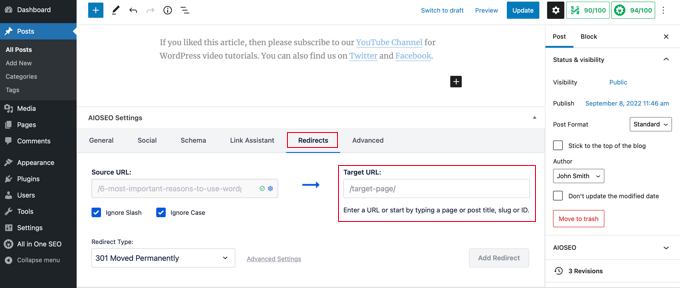
Źródłowy adres URL został już wypełniony. Po prostu wpisz nowy adres URL w polu “Docelowy adres URL” i wybierz “301 Moved Trale” z rozwijanego menu Rodzaj przekierowania.
Ponadto, jeśli zmienisz bezpośredni odnośnik wpisu podczas edycji, AIOSEO zaoferuje przekierowanie starego adresu URL na nowy.
Tak czy inaczej, kliknij przycisk “Dodaj przekierowanie” i gotowe.
Przekierowywanie pełnych witryn internetowych
Jeśli przeniesiesz swoją witrynę internetową na nową nazwę domeny, odwiedzający mogą napotkać niedziałające odnośniki, a SEO witryny może ucierpieć.
Możesz użyć AIOSEO, aby przenieść całą witrynę internetową do nowej lokalizacji bez utraty ruchu lub rankingów wyszukiwarek. Jest to pełne przekierowanie 301 witryny.
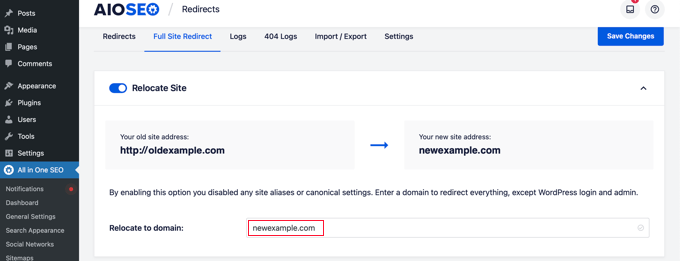
Ważne jest, aby zrobić to we właściwy sposób, dlatego stworzyliśmy przewodnik krok po kroku dla początkujących, jak wykonać pełne przekierowanie witryny za pomocą WordPress.
Metoda 2: Tworzenie przekierowań 301 za pomocą wtyczki Redirection
Innym sposobem dodawania i zarządzania przekierowaniami w WordPressie jest wtyczka Redirection.
Najpierw należy zainstalować i włączyć wtyczkę. Możesz skorzystać z naszego szczegółowego przewodnika na temat instalacji wtyczki WordPress.
Uwaga: Chociaż konfiguracja przekierowań 301 za pomocą wtyczki WordPress jest łatwa, ma ona pewne drobne wady wydajnościowe. W zależności od dostawcy hostingu WordPress, twoje przekierowania mogą być o kilka mikrosekund wolniejsze niż w przypadku innych metod.
Jeśli chcesz, aby twoje przekierowania były jak najszybsze, możesz to zrobić, edytując plik .htaccess przy użyciu poniższej metody 5.
Po włączaniu przejdź na stronę Narzędzia ” Przekierowanie, a następnie kliknij przycisk “Rozpocznij konfigurację”.
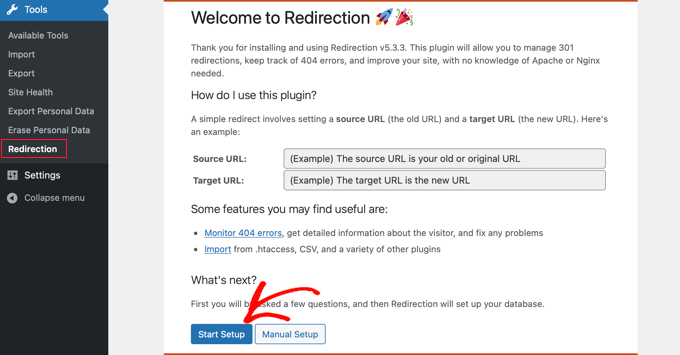
Następnie możesz wybrać opcje monitorowania zmian bezpośrednich odnośników w WordPressie i logować się do wszystkich twoich przekierowań i błędów 404.
Wystarczy włączyć te opcje i kliknąć przycisk “Kontynuuj konfigurację”.
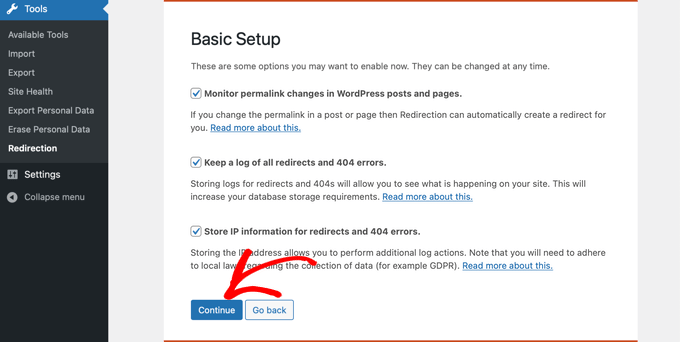
Wtyczka będzie teraz automatycznie testować Rest API.
Gdy status powróci jako Dobry, kliknij przycisk “Zakończ konfigurację”.
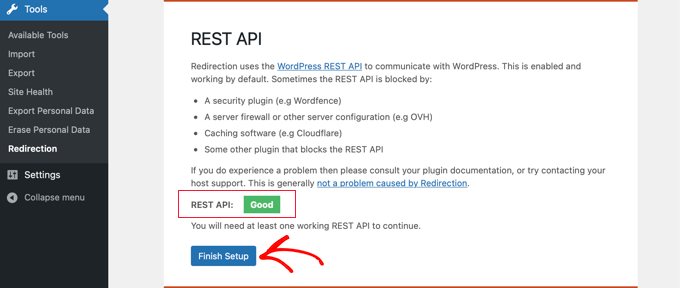
Wtyczka przekierowania wykona jeszcze kilka zadań, aby zakończyć konfigurację. Gdy pasek postępu osiągnie 100%, możesz kliknąć przycisk “Kontynuuj”, a następnie przycisk “Gotowe do rozpoczęcia”.
Wtyczka jest teraz gotowa do tworzenia twoich przekierowań 301. Aby rozpocząć, przejdź do sekcji Narzędzia ” Przekierowania w twoim panelu WordPress. Powinieneś spojrzeć na sekcję “Utwórz nowe przekierowanie” u dołu ekranu.
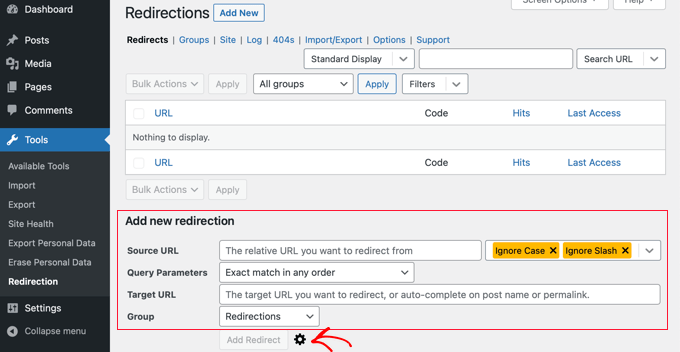
Zobaczysz podstawowe ustawienia, aby dodać przekierowanie. Jeśli jednak klikniesz ikonkę koła zębatego, zobaczysz więcej opcji wyboru twojego rodzaju przekierowania.
Po prostu wpisz źródłowy adres URL twojej starej strony i dodaj “Docelowy adres URL”, na który chcesz przekierować. Powinieneś także upewnić się, że opcja kodu HTTP jest ustawiona na “301 – przeniesione trwale”.

Gdy już wpiszesz wszystkie szczegóły, kliknij przycisk “Dodaj przekierowanie”.
Metoda 3: Tworzenie przekierowań 301 za pomocą wtyczki Simple 301 Redirects
Jednym z najprostszych sposobów tworzenia przekierowań 301 jest wtyczka Simple 301 Redirects. Jak sama nazwa wskazuje, sprawia ona, że przekierowania 301 są naprawdę proste.
Aby rozpocząć, należy zainstalować i włączyć wtyczkę na twojej witrynie internetowej.
Następnie należy przejść na stronę Ustawienia ” Przekierowania 301. Tutaj możesz wpisz stary adres URL w polu “Żądanie” i twój docelowy adres URL w polu “Miejsce docelowe”.

Gdy to zrobisz, kliknij przycisk “Utwórz nowy”, aby utworzyć przekierowanie 301. To wszystko.
Proste przekierowania 301 zaczną działać natychmiast.
Metoda 4: Przekierowanie istniejących stron z odnośnikami do wtyczki
Czasami możesz chcieć zachować wpis na kanale Twojej witryny lub stronę wymienioną w określony sposób w Twojej witrynie, ale mieć treść hostowaną gdzie indziej. W tym miejscu przydaje się wtyczka Page Links To.
Po zainstalowaniu i włączaniu wtyczki, dodaje ona pole meta do twojego edytora WordPress. Tutaj możesz wpisz adres nowej lokalizacji, do której chcesz wysłać swoich użytkowników.
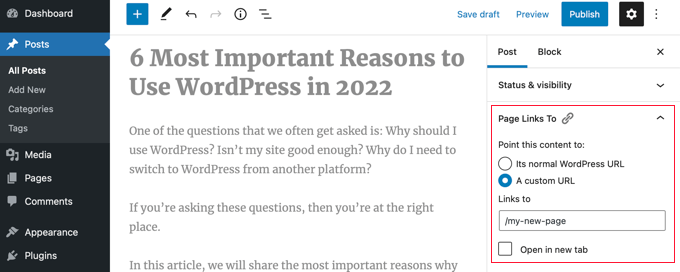
Po naciśnięciu przycisku “Aktualizuj” lub “Opublikuj” WordPress potraktuje wpis lub stronę w normalny sposób, ale gdy ktoś na nią przejdzie, zostanie przekierowany na wybrany konfigurator URL.
Na przykład, możesz mieć bloga, na którym od czasu do czasu tworzysz treści do pobrania, ale chcesz, aby użytkownicy twojej witryny sklepu internetowego widzieli niektóre wpisy jako produkty. Możesz użyć tej wtyczki, aby to zrobić, nie ryzykując kar za zduplikowaną treść od Google lub dzieląc twoją bazę użytkowników.
Metoda 5: Ręczne tworzenie przekierowań 301 przy użyciu .htaccess
Użytkownicy WordPressa mogą również ustawić przekierowania 301 poprzez edycję pliku konfiguracyjnego serwera WWW .htaccess.
Należy pamiętać, że niewielki błąd w kodzie .htaccess może sprawić, że twoja witryna WordPress będzie niedostępna i może zacząć wyświetlać wewnętrzny błąd serwera.
Dlatego ważne jest, aby przed wprowadzeniem jakichkolwiek zmian wykonać kopię zapasową twojego pliku .htaccess.
Edytuj swój plik .htaccess za pomocą wtyczki All in One SEO
Jeśli masz zainstalowaną wtyczkę All in One SEO, to oferuje ona łatwy sposób edycji twojego pliku .htaccess.
Uwaga: Do korzystania z edytora .htaccess wymagany jest program All in One SEO Pro.
Wystarczy przejść na stronę All in One SEO ” Tools i przełączyć się na kartę “.htaccess Editor”.
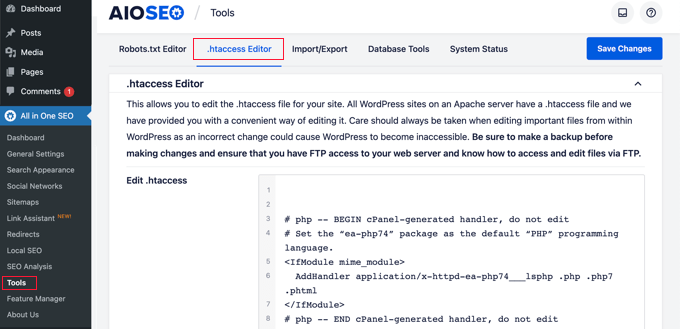
Z tego miejsca zobaczysz treść twojego pliku .htaccess w edytorze. Możesz po prostu umieścić dowolny kod przekierowania, który chcesz dodać na dole po linii “# END WordPress”.
Oto proste przekierowanie, w którym próbujemy wysłać użytkownika przechodzącego na stary wpis do nowego wpisu.
RewriteEngine OnRedirect 301 /a-very-old-post/ http://yoursite.com/a-very-new-post/ |
Nie zapomnij zmienić adresów URL starego i nowego wpisu. Po zakończeniu kliknij przycisk “Zapisz zmiany”, aby zapisać twoje ustawienia, a All in One SEO zaktualizuje twój plik .htaccess.
Bezpośrednia edycja twojego pliku WordPress .htaccess
Możesz również bezpośrednio edytować twój plik .htaccess WordPressa, aby skonfigurować dowolne przekierowania.
Aby edytować plik .htaccess, musisz połączyć się z twoją witryną internetową za pomocą klienta FTP. Plik .htaccess znajduje się w katalogu głównym twojej witryny WordPress.
Jeśli nie widzisz swojego pliku .htaccess, zapoznaj się z naszym przewodnikiem na temat tego, dlaczego nie możesz znaleźć pliku .htaccess na swojej witrynie WordPress.
Możesz pobrać .htaccess na twój komputer i edytować go za pomocą edytora tekstu, takiego jak Notatnik.
Możesz użyć poniższego kodu przekierowania, aby wysłać użytkownika, który przejdzie na stary wpis do nowego wpisu. Kod należy wkleić na końcu twojego pliku .htaccess po linii “# END WordPress”.
RewriteEngine OnRedirect 301 /a-very-old-post/ http://yoursite.com/a-very-new-post/ |
Upewnij się, że zmieniłeś adres URL starego i nowego wpisu. Następnie możesz zapisać twoje zmiany i przesłać plik .htaccess z powrotem na serwer.
Teraz możesz przetestować twoje przekierowanie, aby upewnić się, że przekierowuje prawidłowo, zgodnie z zamierzeniami.
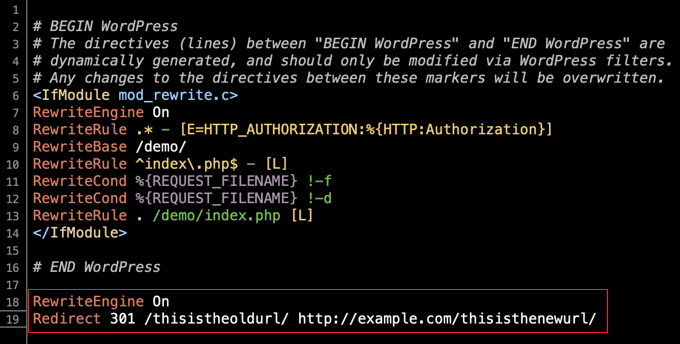
Ponadto możesz również uzyskać dostęp do pliku .htaccess i edytować go za pośrednictwem kokpitu dostawcy hostingu i wbudowanego menedżera plików.
Na przykład, możesz znaleźć .htaccess w menedżerze plików SiteGround, przechodząc do Narzędzia witryny “ Witryna “ Menedżer plików i nawigując do katalogu /public_html/ twojej witryny.
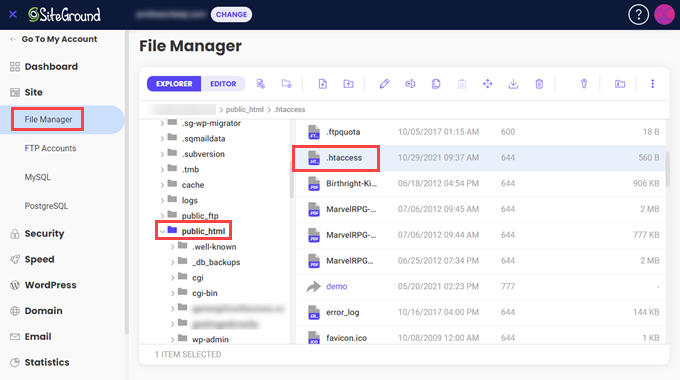
Następnie możesz kliknąć prawym przyciskiem myszy plik .htaccess i wybrać opcję “Edytuj”.
Wystarczy bezpośrednio dodać kod przekierowania 301 i zapisać plik. Ponownie, pamiętaj, aby pobrać oryginalny plik .htaccess w celu utworzenia kopii zapasowej.
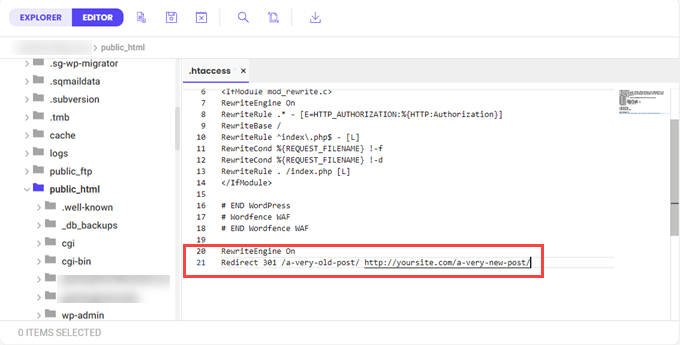
Mamy nadzieję, że ten przewodnik dla początkujących dotyczący tworzenia przekierowań WordPress pomógł ci skonfigurować przekierowania na twojej witrynie. Możesz również zapoznać się z naszym przewodnikiem na temat przekierowywania strony lub adresu URL w WordPress lub zobaczyć nasze wybory ekspertów dotyczące najlepszych wtyczek przekierowujących WordPress.
If you liked this article, then please subscribe to our YouTube Channel for WordPress video tutorials. You can also find us on Twitter and Facebook.





Nick Grainger
Hi, thanks for the helpful article above.
I have switched the permalink format from plain to post, and used the AISEO Pro Redirect function to redirect to the new page URLs. That all seems to be working fine – but now I can’t edit the pages. The system seems to be looking for the original plain format page address to edit. Help!
Thanks in advance for your advice. Nick
WPBeginner Support
The WordPress editor uses the Post ID so changing the permalinks should not affect the editor. Please be sure to clear any caching and if you’re on a localhost installation, ensure you have mod_rewrite enabled in the tool you are using.
Admin
Sheryl
what should I do with the original page after redirecting? Is it better to delete or unpublished?
WPBeginner Comments
As long as proper redirects are in place, you could choose to delete the page if you are certain you no longer need it.
However, sometimes it can be a good idea to turn it into a draft in case you need to reference it later.
Lori Michelle
So I am just trying to understand. We have a wordpress website oldname.com. We rebranded the company and would love to use newname.com, but don’t want to lose any hyperlinks floating out in the world. Can I use the 301 redirect for the whole website on this website? Am I making sense? Help!!!
WPBeginner Support
To change your site’s domain we would recommend taking a look at our article below!
https://www.wpbeginner.com/wp-tutorials/how-to-properly-move-wordpress-to-a-new-domain-without-losing-seo/
Admin
Lori
So I do need to set it up somewhere else, I can’t just change the website URL name and 301 it that way, is that correct?
WPBeginner Support
If you are setting it up on the same hosting provider then you would be able to go to the 301 redirect step as long as you set up the site on the new domain.
Sean
What if you want to redirect a few specific blog posts to a new domain? For example: example.com/blog/hello-world to newsite.com/blog/hello-word. BUT, you don’t need to redirect ALL the old blog content. Just a few specific URLs?
WPBeginner Support
If you wanted it to go to a completely new URL, you would want to place the full URL in the target URL field.
Admin
Donald McKenzie
If I remove comments from my blog, do I need a redirect for the material that was removed. Not the post, just the comments.
WPBeginner Support
No, you shouldn’t need to create redirects for comments that were removed.
Admin
Donald McKenzie
Thank you very much for getting back to me.
WPBeginner Support
Glad we could be helpful
Kanka
Hi, I have a post that I want to delete however after deleting it I plan on redirecting it to a page. Is this okay?
WPBeginner Support
Yes, you can do that, as long as you have the correct URL for your redirect it should be fine
Admin
Kanka
What about the opposite situation which is redirecting a deleted page to a post?
WPBeginner Support
Yes, it works in both directions as long as you redirect the correct URLs.
Anka
I actually don’t have any problems while doing redirects, however, I have more than 50 redirects and plan to do more. Does this cause a problem as I also need to delete categories and some posts?
Rhea
Is there a way I can schedule a redirect?
James
Is there a way to bulk upload redirects via a csv file? It would be handy
WPBeginner Support
The plugin has an option to import via CSV
Admin
hamada
i have made redirection with plugin “Redirection”then i deleted the redirection item from Redirection’s setting ,but i want to get it back the same what should i do
WPBeginner Support
The simplest method would be to recreate the redirect rather than attempting to restore it.
Admin
Esmaeil
I have transfer my site from a domain to a brand new domain. how can I do the 301 redirect without entering address by address?
I mean I want to define something like this : all URLs of example.com goes to example.net for example.
thank you so much in advance.
WPBeginner Support
You would want to take a look at the redirect in our article below:
https://www.wpbeginner.com/wp-tutorials/how-to-properly-move-wordpress-to-a-new-domain-without-losing-seo/
Admin
Tim
I have the redirects set up and working great, but I have a question about finding and replacing all these redirected urls.
Is there a way to find/replace them across your complete WordPress site? Not just within the WordPress database, but also within personal HTML code, and urls within tables using TablePress added to the website.
I’m looking for a global find/replace solution, is there one?
WPBeginner Support
You could either use an analytics tool to find where the link is on your site or you could take a look at a plugin from our previous article below:
https://www.wpbeginner.com/plugins/search-and-replace-plugin-for-wordpress-database/
Admin
Diana
Is there any chance I can implement 301 in free WordPress.com? It says I’m not allowed to install plugins. Only if I’m on business plan. And I want to migrate to WordPress.org
WPBeginner Support
For moving your site from WordPress.com to org you would want to go through our guide below: https://www.wpbeginner.com/wp-tutorials/how-to-properly-move-your-blog-from-wordpress-com-to-wordpress-org/
Admin
Farukh Hussain
Hi,
I have done a redirect some time ago using ‘Redirection’ plugin.
But now I cant find that url in the plugin. Even there is no code for that url in htaccess file too.
I want to disable that redirect now. Is there any way to do this? Pls help?
WPBeginner Support
If the redirect is not in the plugin, you would want to check your htaccess file or reach out to your hosting provider for their assistance with finding the redirect.
Admin
Ginger
If I’m redirecting several web pages (not posts), do I make duplicates of the code you showed above (both lines 1 and 2) for each of the new page I am redirecting? And do I keep copying those codes at the bottom of the .htaccess file?
I read another article that suggests adding redirection codes in the functions.php file in the theme folder. The code is long and seems complicated. But I wonder, which option is more efficient — editing the .htaccess or editing the functions.php?
WPBeginner Support
You would add a new version of the second line of code, you only need the first line once. For where the redirect happens it is personal preference on which method is best.
Admin
Lindsey
Hi
Apparently my site has a 301 redirect on it, but I cannot discover where this is, nor what it is redirecting. There is nothing in the htaccess file. The site was originally built using a different name on localhost, and all the urls were changed to become the new domain name. Could this be the problem? How do I track down where the 301 is because it is causing problems with the SSL certificate. Thanks
WPBeginner Support
Updating the urls shouldn’t be an issue if they were updated correctly. If you reach out to your hosting provider they should be able to help you find what is causing the redirect.
Admin
Jessica
I can’t thank you enough for this simple guide as I’ve always been told to not touch redirects unless you know what you’re doing, so my seo suffered a bit because I ended up not doing anything. Fact is, I know enough and can follow instructions if they’re not written for developers and I don’t have to rely on a plugin that may cause problems later ’cause they all do at some point, right? Thank you. This link is going in my toolbox to share with others having the same problem.
WPBeginner Support
You’re welcome, glad our guide could be helpful for you and anyone you share it with
Admin
Wendy
I used the method in the video, but my site still has Uncategorized listed at the top and the side. I tried to find the third part of the video about changing the 301 redirect links in my settings, but it is not there. However, when I click on Uncategorized it changes to general, but when I visit my site again or refresh it is back to Uncategorized. The plugin for redirects said it was compatible with my theme. Any help is appreciated, thank you.
WPBeginner Support
It sounds like you’re trying to remove the uncategorized category from your site. If that’s the case you would want to take a look at our article here: https://www.wpbeginner.com/beginners-guide/rename-the-uncategorized-category/
Admin
Hannah
Hey there! thank you for the helpful info! I am wondering does this plugin work for a change of domain on my blog? I recently changed my domain and read that it is very important to implement a 301 redirect in order to not lose rankings and exposure. Would this do the trick? If so, would I put my old domain in the source line and the new domain in the target line?
Thank you!
WPBeginner Support
You would want to take a look at steps 4 and 5 in our article here: https://www.wpbeginner.com/wp-tutorials/how-to-properly-move-wordpress-to-a-new-domain-without-losing-seo/
Admin
Matt
Can I use “page links to” and “redirection” one the same site?
They seem like they serve different needs, but I have seen warnings that you shouldn’t use more than one redirection plugin at a time. True?
I like redirection features, but I like having something on the “edit post” view that I can use to set up a redirect (e.g., teaser/excerpt linking out to a landing page or to another site). Thanks!
WPBeginner Support
We would not recommend using the two plugins at the same time to prevent any conflicts between the two, you could check with the plugin authors for if there is a recommended method for the two plugins to work together.
Admin
Bill
I migrated a WP website to a new domain and set up a redirect from the old domain to the new one within cPanel. The redirects are nearly instantaneous (that’s good, right?) but I’d like to delay them for a few seconds, long enough to display a screen on the old homepage explaining why they’re being redirected.
I’m not a programmer. Is there a plugin that will allow me to adjust the time before the redirect occurs? TIA
WPBeginner Support
Unless I hear otherwise, we do not have a simple method we would recommend to set that up sadly.
Admin
Lee
Hello,
A great post by the way.
I have numerous pages which have been redirected to new urls, I have updated all page link urls to the new urls, so no broken links on front end.
My question is after a few months is it safe to delete any redirects which were created?
Many thanks.
Lee
WPBeginner Support
If there are no references to the broken links you could remove the redirects, otherwise it may be best to keep the redirects active.
Admin
Matthew
Hi, I have been using the redirection plugin for a while now trying to sort my old posts out from when I first started ( the permalinks were awful )
What I have been doing is creating another post with a better permalink and copy and pasting the content from the old URL to the new one and then 301 redirecting them.
After reading this post I’m starting to think that I don’t need to create a completely new post but just change the permalink on the old one and redirect it like that, Am I Correct?
If so, can I delete all the old duplicate posts from before or should I leave them as they are?
Thanks if you can help
WPBeginner Support
Correct you can modify the permalink and redirect without the need for the old post to be active. As long as the redirects are in place you can remove the old posts if you wanted.
Admin
Matthew
So just to clarify, I can delete the old posts that I copied and pasted into a new one and redirected the URL, and that all I have to do is to modify the permalink and not copy and paste the whole URL into a different post but just redirect the old permalink to the new one?
Thanks so much for replying to me, you have saved me so much time if that’s the case
WPBeginner Support
Correct, glad we could help
Damion Mower
Once I have set up the redirect, what do I do with the original post, delete it?
WPBeginner Support
While not required, most people do that if they no longer want the old post.
Admin
Focussed Events
Thank you this is just what I was looking for!
WPBeginner Support
Glad we could provide the answer you were looking for
Admin
Lekan
After setting a redirection can I trash the page?
WPBeginner Support
Yes you can
Admin
Wilbert Beltran
Hi, I recently duplicated a site. Let’s say the original site’s url is original.com and I created a subdomain http:testsite.orginal.com where the duplicate site is located. Now, the question is how do I do the redirection with this kind of setup. I want to make the site at original.com to be the main site.
Thanks
WPBeginner Support
For moving your site from a subdomain, you would want to take a look at our article here: https://www.wpbeginner.com/wp-tutorials/how-to-properly-move-wordpress-from-subdomain-to-root-domain/
Admin
Gina
Hi – thank you for this! Love you guys. I downloaded the plugin and have redirected some pages. Can you tell me if I should redirect mysite.com to miresite.com/ – how do I do that? somewhere along the line the “/” fell away. There were 4 different redirect plugins on the WP site I am working on for a client and the site crashed last week – I deactivated them all and installed this one – all is good except for the/ thing. Am I even asking a logical question?
WPBeginner Support
You shouldn’t need to worry about redirecting the site to an address with a / at the end
Admin
Gina
Hi – I have now discovered that my page mydomian.com/ is being redirected to mydomain.com – without the /
I don’t know where this happened or how except from possibly one of the plugins I downloaded?? It is a 301 and I do not know now if this has damaged anything? All the search results show the address with the /. but when the result is clicked it go to the non /. please can you help or send me to somewhere that can help of fix
WPBeginner Support
You would first want to take a look at your plugins if any of them are designed for redirects you would want to see if that is set there. If none of those are causing the redirect you would want to see if the redirect is created in your htaccess file or under Settings>General if the address was changed there.
Tom
Great, thank you, I went with the .htaccess redirect, exactly what I was looking for.
WPBeginner Support
Glad we could help
Admin
Vinca
does this work the same for 302 redirects in an htaccess file? A client has asked to 302 redirect around 800 urls from a wordpress site to a Wix site. There are moments when it all operates fine, then we get several 404’s. Not sure if it’s because there are way too many urls or if we are overlooking something?
WPBeginner Support
The htaccess method would work for 302 redirects if you changed the number to 302. 302 redirects are temporary which could be part of your problem as well as your caching.
Admin
Md firoz ahmed
I have a WordPress site. I face some problem. I am using the woo commerce plugin. Woocommerce site automatically added product category page in my permalinks as- google.com/product-category/up/this-is-my-page. I want to redirect this link like- google.com/this-is-my-page. how can i solve this? any help
WPBeginner Support
For editing WooCommerce’s permalinks, you would want to check under Settings>Permalinks to modify them. If you take a look at WooCommerce’s documentation they explain more in depth.
Admin
Daniel Akinyele
Hi, Wp beginnger, if you could help me i will be do happy, I used the Htacces code and it worked perfectly. But i want My Media Files to redirect to itself,
So is there a code to stop The d=redirection in Wp-contents Folder..pls help me my Website is Dieing
Fahad
Great Information helps me to get out of a serious issue
Michael Wright
Thanks for this! I needed the Redirect plugin. Didn’t know it was a thing
Emmanuel Ekanem
Hello, does this redirection works for a URL complete change?
For example, I’m using olddomain.com and I bought newdomain.com, and want to redirect olddomain.com to open up newdomain.com.
Any help on that??
WPBeginner Support
Hi Emmanuel,
If you do that on your old website, then you will not be able to access it as the plugin will redirect you and your users to new domain name.
Admin
Emmanuel Ekanem
Oops, so how can I achieve this?
WPBeginner Support
You can do that by adding the following code to the .htaccess file on your old site.
RewriteEngine onRewriteCond %{HTTP_HOST} ^oldomain.com [NC,OR]RewriteCond %{HTTP_HOST} ^www.olddomain.com [NC]RewriteRule ^(.*)$ http://newdomain.com/$1 [L,R=301,NC]1-click Use in WordPress
Mauwiks
How can I redirect a single homepage to another domain but the rest of the pages from my redirected domain won’t be affected?/
Lovelyn Montepop
Thank you for this guide. Helped me a lot for a client’s request.
Kavitha
I have a subdomain for affiliate store. I want to know how to redirect from my site page to subdomain page. Please help.
Maegen
Thank You so so much! I have been blogging for about 8 months and have worked so hard to build my Pinterest account. It is where almost all my traffic comes from. A month ago I changed over to https and I didn’t realize until last night that none of my pins were redirecting to the https. I just fixed it all thanks to you!
raj
thanks for the information. i have small doubt how can i redirect old post to new post without loss of comments. i mean i need previous comments
Pearl
Thank you so much. I spent so many hours looking for this and finally got the answer here.
Angelica
Just FYI – the screenshots are out of date I think. Under Add New Redirection, I just see Source/Target URL and Group.
Aaron
Hi, I am trying to find a way to redirect to a single page similar to a 404 when a user enters a non-existent subdomain. for example if they mash the keyboard or make a typo when keying in the domain. I want to get rid of the standard wordpress ‘No Results Found…The page you requested could not be found. Try refining your search, or use the navigation above to locate the post.’
Can someone point me to the solution of this problem? Or what this is called so I can try find the solution? All I’m getting is results about making my multisite a single url…
Thank you!
Abdul Rehman
I only want to redirect when a visitor to my website clicks on an external link from my website. For example, if you were to click on a product from my page it would then redirect you first to a “You are being redirected” page, then off to the affiliate’s website.
I have been spending hours trying to do this. Please help. At this point I just want to know if it is possible with any wp plugin or any other workaround and if so how to do it.
WPBeginner Support
Hi Abdul Rehman,
It is certainly possible, but we are not aware of a plugin that does it.
Admin
Udi Burg
Is there a way to redirect using htaccess and that it will be opened in a new tab?
Laura
Hi
Is it possible to make a redirect from the wix platform to wordpress?
WPBeginner Support
Hi Laura,
Please see our guide on moving Wix to WordPress.
Admin
Hafiz Mateen Afzal
Which plugin is best to create referrel links like:
Thanks
WPBeginner Support
Hi Hafiz,
Thirsty Affiliates is the best way to manage your affiliate/referral links. Please see our guide on how to cloak affiliate links in WordPress.
Admin
cipriana leme
How do I redirect from a wordpress blog (free) to a .com blog? I cannot install plugins in the free blog, so how could I do the redirect? Any advice?
Thanks in advance
Hannah
Hello! I just created a website on WordPress.org and imported all of my content from my old site, example.wordpress.com (using WordPress.com). Is there a way to redirect all of the content from that site to my new one? The redirect instructions provided by WordPress gave me an error that the domain already exists, probably because it thought I was trying to create a new domain on WordPress.com.
My website traffic before is pretty minimal, so if anyone clicks on previous blog posts on my social channels, they’d be taken to the shut down version of my old site without the redirects – not the end of the world because I don’t have the following that would generate clicks at a later date, but you never know?
Any advice anyone has would be great!
Thanks,
Hannah
Senith Nal
your lesson is very helpful. i like it.
Shakoat Hossain
Brilliant solution to reduce redirects for worpress!
For a few days, I’m looking to solve my WP redirects issues. I don’t find out better solution even read this content.
Here, I got few good points and try to reduce redirect to increase my page load speed.
Thanks!